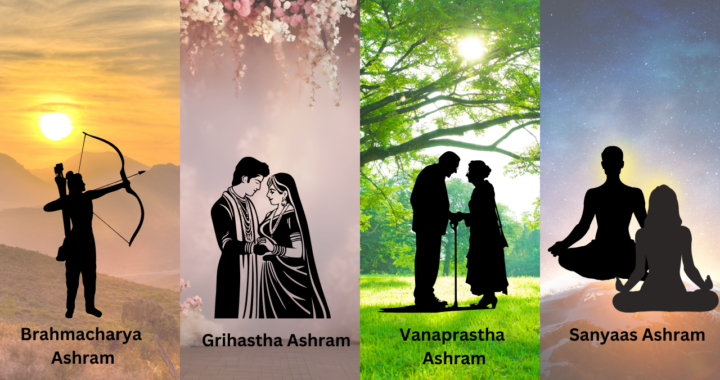
In Hinduism life is divided into four stages each with some specified goal to achieve.
Ashrama comes from the root word ‘shram’ means “to work” very hard for a long time at something. With the prefix ‘a’ Ashrama means a place where one strives towards the goal in a disciplined manner. So at each stage, we have to focus on one goal and for that, we have to follow the rules and regulations of that Ashrama.
This division helps us to focus on the work that we have to do during a particular time of our lives. Each stage has its own set of duties and responsibilities. Each of the four stages helps us to live our lives fully and work towards our last goal moksha.
What are the four stages?
1. Brahmacharya

1st stage of life. Mostly during this age we are full of new energy and curiosity about the world around us. That is why this stage is dedicated to education or student life.
As gaining knowledge is the main goal here thus student has to practice celibacy.
In ancient times during this stage, students had to live in Ashrama. Practice living a simple life away from all life pleasures and focus on achieving knowledge of all kinds.
Mostly first 25 years of life one has to live as a Brahmachari.
2. Grihastha

2nd stage in life. The goal is to live a life of the household where one acquires wealth by fair means, enjoys it, and distributes it among the needy.
Selfless service through the application of arts and sciences learned earlier is the characteristic of this stage.
Only this stage allows sexual gratification.
Give birth to the next generation and teach them life lessons.
Mostly one has to live as Grihastha during 25 to 50 years of age.
If someone lacks interest in marriage, they can choose to remain a Brahmachari or directly transition to the final stage of Sanyasa.
This stage allows experiencing all life pleasures and also gives a chance to complete the three rinas(Dev rina, Pitru rina and sage rina).
3. Vanaprastha

3rd stage in life. The goal is to develop a detachment.
When children are married or give birth to their children. One has to progressively work towards retirement.
How to develop a detachment?
- Allow the youth to take over
- Engaging oneself in a useful social service and
- Introspection and analysis of ways and means to rid ills afflicting the society.
- Focus on spiritual goals
- Sexual relationships are forbidden. Vanaprashta literally means “forest-dweller.
In today’s life going to forest is not feasible, but one can practice this Ashrama by gradually taking retirement from their household duties and practice spiritual life by engaging themselves in Bhakti or social activities.
This Ashrama mostly practice during 51 to 75 age.
4. Sanyaasa

4th and final stage. The goal is to realize our self and attain Moksha.
In life that of renunciation is a preparation to end this worldly sojourn in a happy, peaceful mood and continue the journey towards Moksha.
In this stage
- One has to completely let go of their attachments.
- Let go of responsibilities towards family
- One is completely dedicated to God, with the singular aim of achieving Moksha..
It is said that this stage is not suitable for everyone, who is truly ready and devoted to attain Moksha can only enter in this Ashrama. others will stay as Vanaprastha .
Conclusion
Hinduism is always focus on the live full life and attain Moksha. This stages are the stepping stones to achieve those goals. First two stages help us to explore the world and live it to fullest with taking all the responsibilities and following Dharma. Once we expreiance all in the world we are ready to live it happily, last two stages are gradually prepare us for our happy departure from the world.

